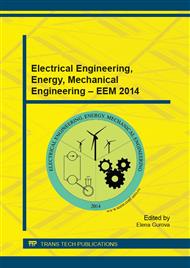[1]
Influence of traction asynchronous motor temperature on its operation modes / A.S. Kosmodamiansky, V.I. Vorobiev, A.A. Pugachev / Electrical Engineering. - 2011. - № 8. - P. 50-54.
Google Scholar
[2]
Chashin, V.V. Improvement of traction asynchronous motor efficiency Повышение эффективности работы асинхронного тягового электродвигателя с учетом его теплового состояния / V.V. Chashin / thesis… candidate in engineering – Moscow, 2004. – 179 p.
Google Scholar
[3]
Kosmodamiansky, A.S. Theoretical bases and development of locomotives traction electric motors temperature control system / A.S. Kosmodamiansky / thesis… doctor in engineering – Moscow, 2002. – 306 p.
Google Scholar
[4]
Yakovlev, A.I. Temperature distribution in asynchronous motors with radial cooling system / A.I. Yakovlev / Electricity. – 1969. - № 9. – P. 65 – 69.
Google Scholar
[5]
Kylander, G. Thermal modeling of small cage induction motors / G. Kylander / Technical report № 265, submitted to the School of Electrical and Computer Engineering Chalmers University of Technology in partial fulfilment of the requirements for the degree of Doctor of Philosophy, Goteborg, 1995. – P. 113.
Google Scholar
[6]
Popova, L. Combined electromagnetic and thermal design platform for totally enclosed induction machines / L. Popova. – Lappeenranta: Lappeenranta university of technology, 2010. – 76 p.
DOI: 10.1109/demped.2011.6063617
Google Scholar
[7]
Thermal model of asynchronous motor for relay protection circuits / A. V, Bulychev [etc. ] / Electrical Engineering. – 2011. - № 3. – P. 26 – 30.
Google Scholar
[8]
P. H. Mellor, D. Roberts, and D. R. Turner, Lumped parameter thermal model for electrical machines of TEFC design, IEE Proc. - Electr. Power Appl., vol. 138, pp.205-218, (1991).
DOI: 10.1049/ip-b.1991.0025
Google Scholar
[9]
G. Champenois, D. Roye, and D. S. Zhu, Electrical and thermal performance predictions in inverter-fed squirrel-cage induction motor drives, Electr. Mach. Power Syst., vol. 22, no. 3, pp.355-369, May/June (1994).
DOI: 10.1080/07313569408955572
Google Scholar
[10]
Balakirev V.S., Dudnikov E.G., Tsyrlin A.M. Experimental definition of an transient characteristics of industrial control objects. – M.: Energy, 1967. – 232 p.
Google Scholar
[11]
Automatic temperature control system of locomotives traction electric motors / A.S. Kosmodamiansky, V.I. Vorobiev, A.A. Pugachev, A.D. Khohlov / Fundamental and Applied Problems of Engineering and Technology, №3 – 2010. – P. 106 – 111.
Google Scholar
[12]
Bespalov, V.Y. Simplified mathematical model of non-stationary heating and coolong of asynchronous motor stator winding / V.Y. Bespalov, Y.A. Moshinsky, V.I. Tsukanov V.Y. / Electricity. – 2003. - № 4 – P. 20 – 26.
Google Scholar


